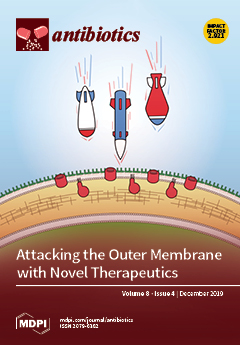Bartonella henselae is a fastidious Gram-negative intracellular bacterium that can cause cat scratch disease, endocarditis in humans and animals, as well as other complications, leading to acute or chronic infections. The current treatment for
Bartonella infections is not very effective presumably due to bacterial persistence. To develop better therapies for persistent and chronic
Bartonella infections, in this study, with the help of SYBR Green I/PI viability assay, we performed a high-throughput screening of an essential oil library against the stationary phase
B. henselae. We successfully identified 32 essential oils that had high activity, including four essential oils extracted from
Citrus plants, three from
Origanum, three from
Cinnamomum, two from
Pelargonium, and two from
Melaleuca, as well as frankincense, ylang-ylang, fir needle, mountain savory (winter), citronella, spearmint, elemi, vetiver, clove bud, allspice, and cedarwood essential oils. The minimal inhibitory concentration (MIC) determination of these 32 top hits indicated they were not only active against stationary phase non-growing
B. henselae but also had good activity against log-phase growing
B. henselae. The time-kill assay showed 13 active hits, including essential oils of oregano, cinnamon bark, mountain savory (winter), cinnamon leaf, geranium, clove bud, allspice, geranium bourbon, ylang-ylang, citronella, elemi, and vetiver, could eradicate all stationary phase
B. henselae cells within seven days at the concentration of 0.032% (
v/v). Two active ingredients, carvacrol and cinnamaldehyde, of oregano and cinnamon bark essential oils, respectively, were shown to be very active against the stationary phase
B. henselae such that they were able to eradicate all the bacterial cells even at the concentration ≤ 0.01% (
v/v). More studies are needed to identify the active components of some potent essential oils, decode their antimicrobial mechanisms, and evaluate their activity against
Bartonella infections in animal models.
Full article






